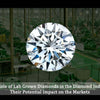
The Top Reasons to Consider Lab Grown Diamond Engagement Rings
The meaning of an engagement ring is profound for both the giver and the receiver. For a very long time, diamonds have been the favored stone for an engagement ring.
However, many people may find the moral and humanitarian concerns associated with diamonds that are mined upsetting. These reasons will help you decide on a lab grown diamond engagement ring.

What are lab-grown diamonds?
An artificially created diamond is created in a controlled laboratory setting using techniques that mimic the planet's naturally high temperatures and pressures. Lab created diamonds resemble natural diamonds closely.
How Does One Make It?
The vast majority of geologists think that diamonds that have been mined developed between one and three billion years ago.
When carbon dioxide was exposed to extreme pressure after being exposed to extreme heat, the process took place 100 miles below the Earth's crust. Diamonds were created when carbon atoms were crushed. They then rose through volcanic eruptions underground.
Currently, scientists can replicate that phenomenon using the following two distinct methods:
High Pressure-High Temperature (HPHT)
The HPHT method, which was developed in the 1950s, is the earliest method for creating synthetic diamonds. The HPHT method can change the color of an existing diamond besides producing new ones.
To make an HPHT diamond, this technique involves putting a microscopic diamond seed in carbon. The tiny seed is put under extreme heat and pressure in a method that mimics how genuine diamonds form underground. The carbon in the seed then melts–creating a diamond.
Diamonds created using the HPHT method frequently have a yellowish hue. This is because nitrogen is present when they develop. They frequently have darker metallic specks as well. Experts may use these metallic particles to determine that diamonds were created in a lab.

Chemical Vapor Deposition (CVD)
The 1980s saw the development of CVD technology. The formation of diamonds in nebular gas clouds is modeled after this process. Compared to the HPHT method, this procedure also uses less pressure and smaller equipment.
A diamond seed is positioned in a vacuum-sealed container that is loaded with carbon-rich gases in the CVD process. The chamber is then heated to roughly 1500 degrees Fahrenheit.
The gas changes in the plasma because of the incredibly high temperatures. The carbon atoms are released because of this process. These carbon atoms then adhere to the diamond seed, forming a carbon diamond.
Reasons To Choose Lab Grown Diamond Engagement Rings
Affordability
With lab grown diamonds, one can spend the same amount on a larger or higher quality diamond. It's surprisingly inexpensive to upgrade the perfect lab grown diamond engagement ring's carat, cut, clarity, or other features.
This is because lab grown diamonds can cost up to 40% less than diamonds that are mined traditionally and are of equal quality. There is simply no reason to purchase a mined diamond when you consider that lab grown diamonds are identical to earth-grown diamonds in every way. They cost a substantial amount less.
Lab grown diamonds may be less expensive than real diamonds. However, it doesn't mean by lack of cutting-edge technology in the manufacturing of lab grown diamonds. Each lab grown diamond starts as a tiny diamond seed. A full-sized diamond is then created using a specific technique of chemical vapor deposition.
Lab diamond rings are the real deal
Real diamonds are pure crystallized carbon in the isometric cubic structure, and lab grown diamonds are the same. The chemical, visual, and physical characteristics of diamonds are the same whether they are created in a lab or mined.
Diamond substitutes are not identical to diamonds found in nature, even as lab grown diamonds are. Many people enjoy the brilliant dazzle of cubic zirconia and moissanite. Nevertheless, they are much less expensive than diamonds since they are not chemically or visually identical to diamonds.
Same Properties: Physical and Chemical
One of the greatest advantages of choosing a lab grown diamond is that it looks identical to a mined diamond to the naked eye.
Diamond detectors and conventional observations cannot distinguish between the two since they are chemically and optically identical. The only significant distinction is that lab grown diamonds bear a microscopic imprint. However, the two kinds of diamonds cannot be distinguished from one another without extremely specialized equipment made to read this inscription.
This implies that nobody you know, even your family and friends, will notice the change. You can have the engagement ring of your dreams without the guilt of using a mined diamond. Lab grown diamond rings offer the same brilliance and sparkle.
Environmentally Friendly Diamonds
Despite their beauty, mined diamonds have a serious detrimental effect on the environment. They need heavy machinery and explosives to start, which disturb ecosystems, taint water, render the land unusable, and produce enormous amounts of chemical waste.
Each carat of mined diamond emits over 125 pounds of carbon. Lab grown diamonds emit only 6 pounds of carbon per carat. In contrast, naturally mined diamonds release over 30 pounds of sulfur oxide, making them less environmentally friendly.
A conventionally mined diamond also needs about 126 liters of water. On the other hand, only 18 liters of water are required for laboratory-grown diamonds. In addition, a significant amount of the energy used to produce lab grown diamonds is renewable.

Diamond mines have significantly impacted the planet's ecosystems because they are among the most important man-made excavations in the world. Contrary to mined diamonds, however, synthetic diamonds are produced in a controlled environment and leave a minimal environmental footprint.
Simply explained, because they are not mined, lab grown engagement rings are better for the environment. Significant environmental harm results from diamond mining. It takes between 88,000 and 176,000 pounds of soil to sift through to find a single 1-carat diamond.
Furthermore, diamond mines are among the largest man-made holes on Earth and have had a significant impact on the eco-system.
Man-made diamond engagement rings are Conflict-free
You’ve likely heard the term "blood diamonds," referring to mined diamonds linked to conflicts and uprisings in Africa. Beyond fueling wars, ethical concerns include unfair wages, poor working conditions, child labor, and human rights violations.
With man-made diamond engagement rings, these grave moral and humanitarian concerns are avoidable. The mining of diamonds involves a lengthy supply chain in addition to ethical concerns. This is because it is considerably harder to verify that the diamond you are buying was ethically obtained.
After all, the origin of a mined diamond cannot be traced as easily as a lab grown diamond. If you buy a lab grown diamond, you can identify the location of the diamond's birth.
Lab grown diamonds are unique and also stylish
Similar to mined diamonds, lab grown diamonds are available in a wide range of modern design alternatives. Lab grown diamonds are available in an array of cuts and settings. Opt for classic shapes such as round, cushion, princess, or oval to suit your style.
If you prefer a different style, lab grown diamonds also come in trendy shapes like heart, marquise, emerald, Asscher, pear, and radiant. They can be set in any design, offering endless fashionable options.
Among millennials, lab grown diamonds are a more and more popular option. You want an engagement ring that has the same appearance and feel as a diamond but that is also inexpensive and conflict-free. You can find exactly what you want with lab grown diamonds while still getting something distinctive and fashionable. You may create an engagement ring with a personalized design while staying within your budget because lab grown diamonds are less expensive than mined diamonds.
Lab grown diamonds provide a stress-free and convenient shopping experience
Although at a much faster rate, the diamond seed is subjected to the same pressure and temperature as mined diamonds when they are grown in a laboratory. The lab produces high-quality gems because the process of developing diamonds in a lab is tightly regulated. This makes buying lab grown diamonds online simple. Why would you make an online diamond purchase? Well, there are some reasons to think about the choice of lab grown diamonds.
First, there’s no pressure to make a purchase—you can take your time browsing without commitment. This allows you to choose a piece you truly love and avoid buyer’s remorse.
Second, traditional jewelry stores often have limited selections. Shopping for a lab grown diamond online provides access to a vast range of loose stones and customization options for building your engagement ring. Best of all, you can do it all from the comfort of your home without needing to interact with anyone.
Customer Service is accessible by phone or email if you have a query regarding the procedure or a particular product. Someone familiar with the stones, shapes, and settings on offer will provide you with the answers you require.
Wrapping It Up
The decision to buy an engagement ring built with a man-made diamond is a personal one. Many people, however, are unwilling to wear an engagement ring that might include blood diamonds. So, for those who want the same appearance but want to know that they were produced ethically, lab grown diamond engagement rings are the ideal substitute.
Your budget will play a role in the engagement ring you select. Lab grown diamonds might make it possible to have a better ring for the same price or less. The most important thing is to select a lab grown diamond that you and your fiancée will value and that you can afford, and also give one part to eco-system.
Leave a comment
Please note, comments must be approved before they are published.










